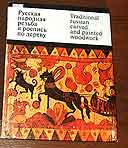Memoirs of Kruglova Olga Vladimirovna (page 5)
 From Tarnoga to Paris
From Tarnoga to Paris
How it was designed! At the bottom on both sides of the blade there were circles with small carved rosettes. The lower part of the blade was completely covered with a pattern of small crossed squares. Above was a strong whirlwind of rosettes in a huge circle. It was a genuine hymn to the Sun! The Sun had filled the whole Universe! It was everywhere, everywhere! The rising sun, the setting sun and the sun in zenith. Its rays were the edges of the radial rosettes. And all those small and big suns were skillfully, easily, artistically combined with a single stroke into the huge rosette. The pattern became majestic and significant. What a faultless sense of decorative tasks! In the upper part in the round plaques there was a carved inscription: “The distaff of a peasant woman Nastasii Alexeyevna Shibanova”.
Who was the owner of that wonderful distaff ? Was she a girl or a young woman? Who gave that priceless gift to her? Was it a wedding present from her beloved, or her father’s gift in her dowry? Was Nastasii Alexeyevna’s life happy? The beautiful distaff did not answer.
Examining it thoroughly, I could not keep back a happy smile. It was an exceptionally beautiful work of art.. How remarkably the pattern emphasized the shape. Even the sides of the low part were carved, which was a rare case, indeed. And the steep rise of the base was decorated with a relief comb that seemed to fix our eyes on the basic pattern on the inner part of the blade. It consisted of the rosettes combined into an integral composition. It was, as thick as the pattern on the facade, but it covered just the bottom of the blade. It was not a huge round rosette, but a half of it that looked, like the setting sun. And there was untouched smooth wood above. Could that be the night sky?
In the upper part there was another inscription, which was even more valuable for us: “This distaff is made by a peasant of Dub… village Stepan Ogloblin on the 29th of December, 1890”.
I read the inscription and looked at the dropped curtain. I could jump up and thank the woman. I was ready to embrace her. Then I shared my joy with all people out loud. I read the inscription stressing it importance. The audience began to applaud.
- You are right, dear friends. Stepan Ogloblin, who made this distaff, deserved
the applause.
— At the interval the distaff passed from hands to hands. Almost all held it and admired their fellow-villager’s art. At night I did not tie it to the soft seat in the bus, like all other items. I put it on my knees and, holding to the handrails with one hand, tried to prevent it from hard push.. I was delighted with the radial rosettes that shone like the bright sun at white night. And now I recall another moment in life of this wonderful work of art. In 1973, I saw Frenchmen, fascinated with its rare beauty, at the exhibition “Russian Woodwork” in Grand Palais in Paris. The Parisians received the whole exhibition warm, and in the last hall, where works of folk art and distaffs, of course, were presented, the visitors examined each item with great interest. But before the distaff, made by Stepan Ogloblin, there always was a group of real connoisseurs of art. The splendid catalogue, designed by the Frenchmen, included it into a small group of colored illustrations, as a masterpiece of Russian carved wood.
|


